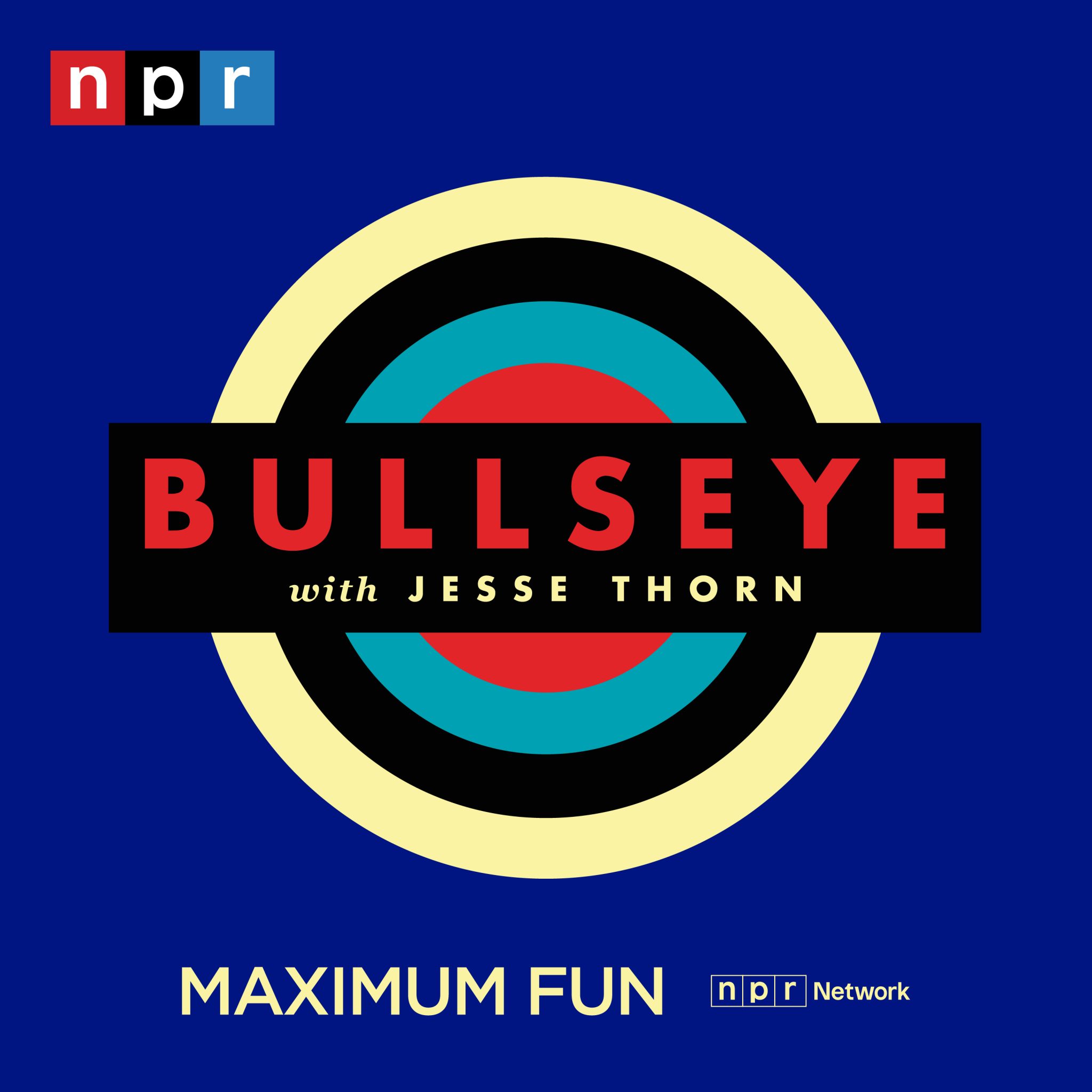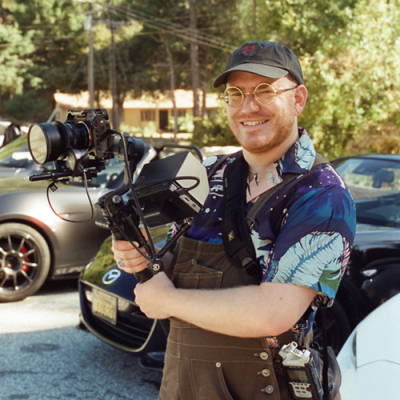Transcript
[00:00:00]
Transition: Gentle, trilling music with a steady drumbeat plays under the dialogue.
Promo: Bullseye with Jesse Thorn is a production of MaximumFun.org and is distributed by NPR.
Music: “Huddle Formation” from the album Thunder, Lightning, Strike by The Go! Team—a fast, upbeat, peppy song. Music plays as Jesse speaks, then fades out.
Jesse Thorn: It’s Bullseye. I’m Jesse Thorn. Like the best games, the idea is very simple. A ball rolls around. Anything smaller than the ball sticks to it, and the ball gets bigger. Anything bigger than the ball is an obstacle, a roadblock. You bounce off that. Get the ball big enough to get the biggest thing, you move on to the next level. If that game came out now, I guess it would be on your phone. One of those apps that your kid accidentally drops 50 bucks in to get star points. Probably not a story thing. It would be called Roll Ball Deluxe or something. Million-dollar idea. (Brushes off his hands.) Done.
But Katamari Damacy, that is the name of the game we are talking about in real life. Katamari Damacy came out in 2004 on PlayStation. At first, it was a so-so success. Then it was a big success. Now, it is a legendary classic. And because it came out in 2004, and because of the unusual mind from which it came, there is a story—a whopper of a story. The king of the cosmos, who is a godlike, fancy, royal being, has thrown the universe into chaos. He’s destroyed all the stars. He has made a mess of things. And you, a tiny prince, must rebuild it paperclip by paperclip, then goose by goose, cow by cow, eventually cars and trucks and whole buildings. And of course, there is the classic soundtrack.
Music: “Katamari on the Rocks” from the album Katamari Damacy (Original Soundtrack) by Yuu Miyake and Masayuki Tanaka.
Na, na, na, na, na, na, na, na, na
Na, na, na, na, na, na, na, na, na
(Jesse sings along over the music.)
Katamari, do your best (ow!)
Picnic kibun, feel so good (huh!)
Suteki na afternoon
(Music fades out.)
Jesse Thorn: My guest, Keita Takahashi, created Katamari Damacy. He did so at Namco, a company best known at the time for fighting games like Tekken and Soul Edge. And as you might have gathered, Katamari Damacy is not Tekken or Soul Edge. Katamari changed what big video games could be. They could be unique, simple, weird, hilarious, and even still be hits.
Music: “LONELY ROLLING STAR” from the album Katamari Damacy (Original Soundtrack) by Yohihito Yano and Saki Kabata.
(Music fades out.)
Jesse Thorn: To celebrate the 20th anniversary of Katamari Damacy, you can now listen to the soundtrack on streaming platforms everywhere. And—and! Keita Takahashi has a new game coming out. It’s called To a T. It’s about a child whose arms stick straight out. Like a T. Alright, let’s get into it. My interview with the great Keita Takahashi.
Music: “You Are Smart” from the album Katamari Damacy (Original Soundtrack) by Akitaka Tohyama.
(Music fades out.)
Jesse Thorn: Keita, welcome to Bullseye. I’m so happy to have you on the show.
Keita Takahashi: Hey, I’m so nervous. (Chuckles.)
Jesse Thorn: No, don’t worry about it. You’re already doing great. We’ve got you set up with an interpreter and a computer to show me your new game. Everything is working—so we’ve already won, as far as I’m concerned.
Keita Takahashi: Yeah, but the me is still a problem. (Laughs.) I hope I work.
Jesse Thorn: What were your favorite kinds of games when you were a kid?
Keita Takahashi: I was so enjoying to play with my friends. One of my friends has tons of the games. So, every day, we just went there, went to his house to play after the school. (Laughs.) But I wasn’t sure if I wanted to be a game designer or not. I just enjoyed the game.
Jesse Thorn: Did you think of it at all when you were a kid? Did you ever think, “I want to work in video games”?
Keita Takahashi: Nooo, not at all.
Jesse Thorn: What did you think?
Keita Takahashi: (Laughs.) When I was a kid, I wanted to be a pilot.
[00:05:00]
Jesse Thorn: Really?
Keita Takahashi: For the airplane, of course. You can travel free. (Laughs.)
Jesse Thorn: What about when you were an adolescent? What about when you were a teenager?
Keita Takahashi: Hm. I don’t think I have anything that I want to be as a teenager. I just was so busy to survive the teenage life. I was learning the art when I was under—like, before I start the preschool, my mom let me go to the art school. And that was so fun. I was very good at the painting or drawing something. But after elementary school, I stopped drawing or something. But in high school, I just realized that drawing art or making something is what I want to do after I graduate. I decided to go to art college. So, to become an artist is not what I wanted.
Jesse Thorn: You wanted to make stuff.
Keita Takahashi: Yeah, that’s it.
Jesse Thorn: Was there something that you made that you were proud of? It’s hard to be proud of things. It’s both easy and hard to be proud of things, when you’re a teenager, that you made.
Keita Takahashi: Yeah, there’s nothing. But I’m still proud of what I made in the art college, which is not in the teenager, (laughs) because it’s after the 20.
Jesse Thorn: When you were in art college, did your classmates want to be fine artists, like gallery artists?
Keita Takahashi: I don’t know, because I have no friends in the college.
(They laugh.)
Jesse Thorn: Really?
Keita Takahashi: Yeah, maybe a few. (Chuckles.) I was so picky. I mean, I’m still picky. For me, at the moment, and at the time, the other students—yeah, like I saw the other students throwing away the object that they made in the art class, and I hate it. Even if it’s a prototype or like studied stuff. I didn’t want to throw it away and make it garbage. That’s kind of one of the reasons I don’t—(laughs) I didn’t have any friends. I was so biased and very narrow perspective, which is so ridiculous.
Jesse Thorn: Did you want to keep the things that you had made?
Keita Takahashi: As much as possible. So, my plan is—I just realized, oh, maybe I should make a tool, not as art. Even me, even right now, I don’t know what art means. But yeah, I decided to make a tool, but not sculpture.
Jesse Thorn: Something useful.
Keita Takahashi: Yeah, something useful. The sculpture I made first was a flowerpot shaped like a goat.
Jesse Thorn: I’ve seen a picture of this goat flowerpot!
(They laugh.)
Keita Takahashi: Yeah, that was great invention to me.
Jesse Thorn: I agree! I was like, oh man, I want—why are all my flowers planted in flowerpots instead of goat flowerpots?
Keita Takahashi: Yeah, that was so stupid.
Jesse Thorn: It looks like it’s the size of a goat too. In the pictures.
Keita Takahashi: Yeah. Mm-hm. Mm-hm. And then, yeah. That thing is the first object that I made that I can be proud of me. And I still can’t forget when I presentation to the other students or teacher or professor. So, there’s no soil on the back, but I just brought my—like a water bin and just pour in the water then.
Jesse Thorn: Did you put a towel on the ground?
Keita Takahashi: (Laughs.) No, sorry. I should have. I should have.
Jesse Thorn: (Laughs.) We’re going to take a quick break. We’ll be back in a minute. When we return, even more with legendary video game creator Keita Takahashi. It’s Bullseye from MaximumFun. org and NPR.
[00:10:00]
Transition: Thumpy synth with light vocalizations.
Jesse Thorn: Welcome back to Bullseye. I’m Jesse Thorn. My guest is Keita Takahashi. 20 years ago, he created and designed the classic video game Katamari Damacy. It’s a completely unique and profoundly bizarre game in which you play a little, tiny prince who rolls a little, tiny ball around. And the ball is sticky, and it gets bigger and bigger as it gets stuff stuck to it. Also, there’s amazing music and a kind of space god who bosses you around and is very sassy! Wonderful game. Maybe the best ever. In the observation of Katamari Damacy‘s 20th anniversary, the studio that created it is releasing the game’s wonderful soundtrack on all streaming platforms.
And Takahashi is hard at work on a new video game set to be released later this year, called To a T. A couple years after he finished school, basically on a whim, he applied for a gig making video games. He didn’t have any experience. He didn’t really play video games, but guess what? He got the job. That job was at Namco, the video game publishing company behind games like Pac Man, Tekken, and Galaga.
When did you get the chance to pitch ideas for games at work?
Keita Takahashi: Usually the new employee doesn’t have any chance to pitch the new game. But the creative boss helped me to pitch the game, and that was Katamari Damacy.
Music: “The Na-Na Song” from the album Katamari Damacy (Original Soundtrack) by Yuusama.
Na, na, na, na, na, na, na, na, na, na, na, na, na
Na, na, na, na, na, na, na, na, na, na, na, na, na
Na, na, na…
(Music fades out.)
Jesse Thorn: Really? That was your first pitch?
(Keita confirms.)
What did you—I mean, even now, as someone who played hours and hours and hours of Katamari Damacy, I’m not 100% sure how I would pitch that game to my boss at the video game company. (Laughs.)
Keita Takahashi: Really?
Jesse Thorn: Do you remember what you said? Did you bring pictures?
Keita Takahashi: No, I don’t think so. I just talked with him. But before I talked with the boss—I have a—finally, I got a friend.
(They laugh.)
He’s a game designer. Since I’m an artist, I ask him. I talk with, “This idea would be the game.”
And then he said, “No, no, no.” But this time, yeah. He said, “Yes, wow, this could be the game.”
And I (gasps), “Really?” (Laughs.) I’m surprised. And then I just really polished my idea. But at that time, I don’t think—I even didn’t draw something. I just speak to my boss and let him know my idea.
And then he said, “Wow! That’s great.”
Jesse Thorn: So, you just went into your boss’s office at a company that made regular video games. Big, regular video games. And said, “I have an idea for a game. The King of the Cosmos accidentally destroyed all the stars, and to get them back, the prince has to roll everything up into a ball and throw it into the sky…”
Keita Takahashi: (Chuckling.) No, no, no. Not at that moment. Not yet. Those details will be there later. Yeah.
Jesse Thorn: So, was it just “my idea is what if you could roll everything up in a ball”?
Keita Takahashi: Yeah, that’s it. So, when I got the idea, I was walking back to the station at night, and I keep thinking what I’d like to make as a game designer, even though I was an artist. Because there was a great opportunity to make a video game as a creator in the game company. So, the artist just drawing the art or designing the character is not fun to me. I wanted to make a game.
[00:15:00]
So, since I joined Namco—which is the company I joined—I keep thinking the game idea that one day, when I go back to walking to the station in the night, just the idea… literally like a drop from the sky in my brain. I saw rolling object, a spinning the object. And then when I ride on the train, the object start moving and then pick up something. And then getting bigger.
Jesse Thorn: Like a snowball.
Keita Takahashi: Yeah. And then when I get off the train, and then the ball is getting bigger, then rolling up everything. The next day, I talk with my—like I mentioned earlier, like a game designer friend. And he said, “Wow, that’s great!”
Music: “WANDA WANDA” from the album Katamari Damacy (Original Soundtrack) by Yuu Miyake.
(Music fades out.)
Jesse Thorn: Were you surprised that he said that? I mean, this was a company that, you know, made famous early arcade games—Pac Man and Dig Dug and those sorts of things. But by the time you were working there, they were famous for making—I guess, probably Tekken.
Keita Takahashi: Yeah, Tekken.
Jesse Thorn: A fighting game or…
Keita Takahashi: Racing game. Like Ridge Racer.
Jesse Thorn: Racing games, Soulcalibur—which is a fighting game with a lot of swords in it, I think.
Keita Takahashi: Yeah, I know for some people, that would be the best game ever, but for me, not.
Jesse Thorn: Right?
(They laugh.)
Keita Takahashi: Yeah, I really like the games that Namco made before, like Dig Dug or Pac Man. That was so new, even though it’s old, and unique. I wanted to get back that vibe. So, that’s kind of the reason why I also put the weird character into the game, like King of Cosmos or Prince.
Jesse Thorn: The King of All Cosmos in Katamari says lots of stuff. The sound that you hear on the soundtrack is a record scratching, but he says lots of goofy, crazy stuff. And the way that it’s written is very specific, at least in English. And I always wondered if it was intentionally odd or just a very literal translation that came out odd.
Keita Takahashi: (Laughs.) I wrote Japanese version, like all-Japanese version text. But my colleague, coworker—which is working at the localization department—they told me it was so difficult to translate my Japanese text to English properly. Then finally they found a nice translator. That means it is all intentional.
Music:
Music: “Fugue #7777” from the album Katamari Damacy (Original Soundtrack) by Sakai Asuka.
(Record scratch sounds play over the music which plays under Jesse speaking then fades out.)
Jesse Thorn: “Here we are, Earth. Full of things as usual. Hm? Hm?! Ack! So, so small! You’re as small as ever. We didn’t notice, not one jot, what with the stars and all. What is that? That body? That physique? Could you really be our son? Aha! I’ve got it! Build katamari. Work out and get bigger.”
[00:20:00]
I just—there’s a wiki that just has everything he says on it. (Laughing.) He also, when you roll a mosquito into the katamari, he says, “Mosquito!”
Keita Takahashi: What’s wrong? Yeah, it’s a mosquito.
Jesse Thorn: There’s so many things that are so specific about Katamari Damacy and not like other things that what I imagine is people bringing you their project, their piece—you know, their little piece of the game—and you saying, “It has to be much less like other games.”
Keita Takahashi: Do you think so?
Jesse Thorn: I think so, yeah. I’ve played it.
Keita Takahashi: Really? Well, even me, when I was making the Katamari, I feel like, “Oh, this is just a Pac Man in 3D.” That’s it. Nothing changed. Just, additionally, just the ball is getting bigger. That’s the point, but besides that, it was not so unique idea for me. And even, that—maybe because I was tired, but during the QA time—
Jesse Thorn: That’s quality assurance. That’s like checking for bugs in the game.
Keita Takahashi: Yeah. The games makes me so sleep.
(Jesse laughs.)
Because looking at the rolling object on the screen, that makes me sleep.
Jesse Thorn: Yeah, I mean, it’s mesmerizing, for sure! Even though it’s cheerful and there’s upbeat music playing, there’s something so calming about gathering—even though funny things are happening all along, you know. When you roll—there’s no way not to laugh at rolling up a cow into a ball. But it does have a kind of hypnotic effect. (Laughs.)
The thing that I remember the most about playing Katamari Damacy is the aesthetics. So, both the way that it looks—which is flat colors. I don’t know how to describe the—it’s a kind of cartooniness without exaggeration. It’s literal but flat and very colorful. And also, music that—I remember playing that game, and I had never heard music like that in a video game.
Music: “The Moon and the Prince” from the album Katamari Damacy (Original Soundtrack) by Akitaka Tohyama and Kenji Ninuma.
You! Ha! Get up!
You! Ha! Get up!
(Music continues under the dialogue.)
Jesse Thorn: We’ll finish my conversation with Keita Takahashi after a quick break. When we return, we will talk about his upcoming game, To a T and why I can’t wait to play it. It’s Bullseye from MaximumFun.org and NPR.
Music: “The Moon and the Prince” by Akitaka Tohyama and Kenji Ninuma.
Mawashita, mawatta, teatari shidai ni korogashita
Kuttsugeta, kumikonda…
(Music fades out.)]
Transition: Thumpy synth with a syncopated beat.
Jesse Thorn: It’s Bullseye. I’m Jesse Thorn. I’m talking to Keita Takahashi. He created the video games, Katamari Damacy, and the upcoming To a T.
There’s a famous video game glitch in a basketball game where this center for the Los Angeles Lakers, Andrew Bynum—former center for the Los Angeles Lakers—who was mostly known for being husky for a guy as tall as he was, where he is stuck with his arms sticking straight out. And it’s really funny, because he’s a basketball player. And it’s not human. It’s supposed to be a human character, and it’s not human to stick your arms straight out. Your new game is that as a game.
(They laugh.)
I haven’t played it yet, but it seems to be about a boy whose arms stick straight out and can’t do anything else.
Keita Takahashi: Right. It’s not a boy, just teenager. Do you like it? I know you don’t—you haven’t played.
[00:25:00]
Jesse Thorn: The part that’s the most exciting to me is how—is that he has a dog to help him do stuff. He has like a service dog for people whose arms stick straight out. Before we even get further into it, I want to play the song. The trailer has a song that’s about the game that I’m in love with, so let’s listen to some of that song with lyrics that just describe the game, basically.
Music: To a T’s trailer song.
I want to change PJs
I want to dry my face
I want to use the restroom by myself
(Dog barks.)
The little things, yeah
The little things are hard for me
Oh, I don’t know why I am T
It’s not so bad all the time
(It’s not so bad)
My cute dog helps me out
So we can go and la-la-la-la-la
I don’t know how I became the shape of T
(Never forget, you’re the perfect shape!)
But I can spin so fast, I can fly in the sky
(Believe in yourself, you’re the perfect shape!)
(Music fades out.)
Jesse Thorn: Did thinking about this boy going through just the normalest, regularest, most everyday tasks of his life make you think about what going through your everyday life was like when you were a kid or a teenager?
Keita Takahashi: Definitely, the teen gets some trouble in the school because the T shape—that’s unique, right? Not usually happening. Also, yeah, I have bullied in the middle school in Japan. That was not so great memory, I think I got lucky that I could get through the bad experience in good shape. (Laughs.) That experience makes me grow up. (Beat.) Oh, that’s not related to the video game, but yeah.
Jesse Thorn: I think it is related to the video game! I mean, there’s not a lot of people who create art who didn’t feel—it’s not a lot of people in general, but especially not a lot of people who create art who didn’t feel different and uncomfortable and wrong in some way when they were adolescent. Now most of them didn’t have arms that stuck straight out.
Keita Takahashi: Unfortunately, yeah. That’s true.
(They laugh.)
But it’s very interesting, right? Just the characters doing the T pose, how we feel so special about that. Even—I do remember—I still do remember like when I pitched this idea to the publisher. It seemed like they liked the idea, then they just start hitting each other with this T pose.
(They laugh.)
I saw that moment like, “Oh, this game would be very fun and nice.” Just a T pose in the 21st century in the PlayStation—like a next generation PlayStation 5 or Xbox X or S. I feel so lucky that I got such a simple idea.
Jesse Thorn: Do you just have a list in your office, on your wall, of weird things you noticed that you might be able to spend 10 years making into a video game?
Keita Takahashi: I don’t have a wall at my desk, because my desk is in the garage. The wall is super far away, but yeah. I wish—I’m hoping I’m keeping creative somehow. It doesn’t need to be game designer. I tried to be a playground designer at some point, but I failed.
Jesse Thorn: Your ideas were too expensive?
Keita Takahashi: Yeah, but that is still kind of one of my dreams. So, once I get billionaire by making the game, then I’m gonna spend my most of my money (laughs) to make my private playground.
Jesse Thorn: Well, Keita, it was really nice to get to talk to you.
[00:30:00]
And you’ve made some of the works of art in my life that have brought me the greatest joy and pleasure, so thank you for that.
Keita Takahashi: Thank you.
Jesse Thorn: I really appreciate it.
Keita Takahashi: Thank you for having me.
Music: “Que Sera Sera” from the album Katamari Damacy (Original soundtrack) by Asuka Sakai and Charlie Kosei.
Daba-da-ba, do-do-do-do, do-do-do, daba-da-ba
(Music continues under the dialogue.)
Jesse Thorn: Keita Takahashi. Special thanks to his interpreter, Ai Saito, for helping facilitate our conversation. Keita’s newest game, To a T, is set to come out later this year. Keep your eyes peeled. If you haven’t played Katamari Damacy, I can’t even begin to tell you how much you should. Oh, it is just the absolute best. His other work is really amazing too. Katamari is on PlayStation 4, Xbox One, Switch, and Windows PC. Katamari, do your best!
Music: “Que Sera Sera” by Asuka Sakai and Charlie Kosei.
Let’s roll up to be a single star in the sky
I hear you calling me
I wanna wad you up into my life
Let’s lump up to make a single star in the sky
To you, to you
(Music continues under the dialogue.)
Jesse Thorn: That’s the end of another episode of Bullseye. Bullseye, created from the homes of me and the staff of Maximum Fun, in and around greater Los Angeles, California. It’s baseball season here in Los Angeles. My producer, Kevin, is wearing his Dodgers hat. I’m wearing a Giants sweatshirt. And never the twain shall meet, except for the last three days when the—(softly) when the Dodgers beat the Giants.
The show is produced by speaking into microphones. Our senior producer is Kevin Ferguson. We’ll be back. Our producers are Jesus Ambrosio and Richard Robey. Our production fellow at Maximum Fun is Daniel Huecias. We get booking help from Mara Davis. Special thanks this week to Arielle Flinkman with Women’s Audio Mission in San Francisco for recording my interview with Keita Takahashi. Our interstitial music is by DJW, also known as Dan Wally. Our theme song is called “Huddle Formation”, written and recorded by The Go! Team. Thanks to them and to their label, Memphis Industries.
You can find Bullseye on Instagram, @BullseyeWithJesseThorn. I also just started a new Instagram account. You can follow me @JesseThornVeryFamous. Bullseye is also on Twitter, YouTube, and Facebook, and I think that’s about it. Just remember, all great radio hosts have a signature signoff.
Promo: Bullseye with Jesse Thorn is a production of MaximumFun.org and is distributed by NPR.
(Music ends.)
About the show
Bullseye is a celebration of the best of arts and culture in public radio form. Host Jesse Thorn sifts the wheat from the chaff to bring you in-depth interviews with the most revered and revolutionary minds in our culture.
Bullseye has been featured in Time, The New York Times, GQ and McSweeney’s, which called it “the kind of show people listen to in a more perfect world.” Since April 2013, the show has been distributed by NPR.
If you would like to pitch a guest for Bullseye, please CLICK HERE. You can also follow Bullseye on Twitter, YouTube, and Facebook. For more about Bullseye and to see a list of stations that carry it, please click here.
Get in touch with the show
People
How to listen
Stream or download episodes directly from our website, or listen via your favorite podcatcher!






